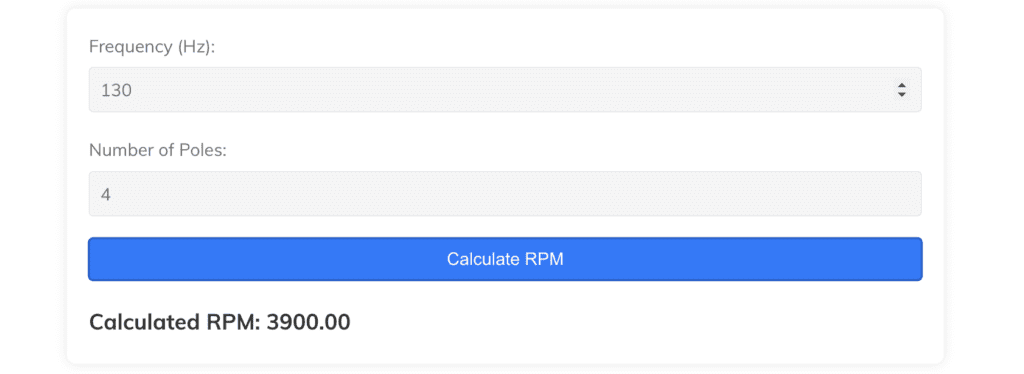Pole to Rpm Calculator : “Pole to RPM” refers to the relationship between the number of magnetic poles in an electric motor and the motor’s rotational speed, which is commonly measured in revolutions per minute (RPM). This relationship is particularly significant in the design and operation of AC (alternating current) motors, especially synchronous motors.
Poles of Motor
In an electric motor, a pole refers to a magnetic pole, either north or south, that is part of the motor’s construction. Electric motors commonly have multiple poles arranged around the stator, which is the stationary part of the motor.
Here are the key points about motor poles:
- Stator Poles: In most electric motors, the stator contains a series of poles. These poles generate a rotating magnetic field when electric current flows through them. The number of stator poles has a significant impact on the motor’s speed and torque characteristics.
- Rotor Poles: In some types of motors, such as synchronous motors, there is also a rotor with its own set of magnetic poles. The interaction between the stator and rotor poles is what allows the motor to generate torque and rotate.
- Synchronous Speed: The synchronous speed of a motor is directly related to the number of poles and the frequency of the power supply. The formula for calculating synchronous speed (in RPM) is:Synchronous Speed (RPM)=120×Frequency (Hz)Number of PolesSynchronous Speed (RPM)=Number of Poles120×Frequency (Hz)This formula indicates that motors with more poles will have a lower synchronous speed, and those with fewer poles will have a higher synchronous speed, assuming a constant frequency.
- Speed and Torque Relationship: The number of poles in a motor also influences its torque characteristics. Motors with more poles tend to have higher torque at lower speeds, making them suitable for applications requiring higher starting torque.
- Common Pole Numbers: Motors can have various numbers of poles depending on their design and application. Common numbers include 2, 4, 6, 8, and so on.
Understanding the number of poles in a motor is crucial for selecting the right motor for a specific application, as it affects the motor’s speed, torque, and overall performance.
How to use the Pole to RPM Calculator
- Open the Calculator:
- Visit Pole to RPM Calculator
- Enter the Frequency:
- Locate the box or space labeled “Frequency (Hz)”.
- Type in the frequency of your electrical supply. Common frequencies are 50 Hz or 60 Hz, depending on your location.
- Enter the Number of Poles:
- Find the box labeled “Number of Poles”.
- Input the total number of magnetic poles in your motor.
- Click “Calculate RPM”:
- Look for a button, often labeled “Calculate RPM” or similar.
- Click on the button to perform the calculation.
- View the Result:
- After clicking the button, the calculated RPM (Rotations Per Minute) will be displayed.
- The result will provide insight into the expected rotational speed of your motor based on the entered frequency and number of poles.

Basics of Electric Motor Operation
- Electric Motors: Motors convert electrical energy into mechanical energy. In AC motors, this is achieved through a rotating magnetic field produced in the stator (the stationary part of the motor).
- Magnetic Poles: Magnetic poles in a motor are created by winding coils around the iron core of the stator. When alternating current passes through these coils, it creates magnetic fields. Each winding pair forms a pole; one north and one south.
Synchronous Speed
The rotational speed of a synchronous motor is determined by two key factors: the frequency of the AC power supply and the number of magnetic poles in the motor.
- Synchronous Speed Formula: The formula to calculate the synchronous speed of a motor is: [ \text{RPM} = \frac{120 \times \text{Frequency (Hz)}}{\text{Number of Poles}} ] In this formula:
- RPM is the rotational speed of the motor.
- Frequency is the frequency of the AC power supply in Hertz (Hz). In many countries, this is typically 50 Hz or 60 Hz.
- Number of Poles refers to the total number of magnetic poles (north and south) in the motor.
- Example Calculation: For instance, if you have a motor connected to a 60 Hz power supply and it has 4 magnetic poles, the synchronous speed would be calculated as: [ \text{RPM} = \frac{120 \times 60}{4} = 1800 \text{ RPM} ]
Importance of Pole Count
- Speed Control: The number of poles is a crucial factor in determining the motor’s speed. More poles mean a lower speed, and fewer poles result in a higher speed. This is because the magnetic field takes more time to complete a rotation around the stator with more poles.
- Torque Characteristics: Motors with more poles typically have higher torque at lower speeds, which is beneficial for applications requiring high starting torque.
Types of Motors
- Synchronous Motors: These motors run at the synchronous speed determined by the power supply frequency and the number of poles. They are often used in applications where a constant speed is needed.
- Induction Motors: These are the most common type of AC motor. They do not run exactly at the synchronous speed due to slip, which is the difference between the motor’s synchronous speed and its actual speed under load.
Application and Significance
Understanding “pole to RPM” is essential in motor design and selection. When choosing a motor for a specific application, engineers consider the required speed and torque characteristics, which are directly influenced by the number of poles in the motor. This relationship allows for the customization of motor performance to suit various industrial and commercial applications.
Use our other tools:
- Find Solar Declination Based on Your Zip Code | Solar Declination Calculator
- Time Clock In and Out Calculator
- Bottleneck Calculator | Calculate Your System Bottleneck based on CPU GPU Specifications
- Hardy-Weinberg Equilibrium Calculator for 2 alleles
Wikipedia on Synchronous motor


